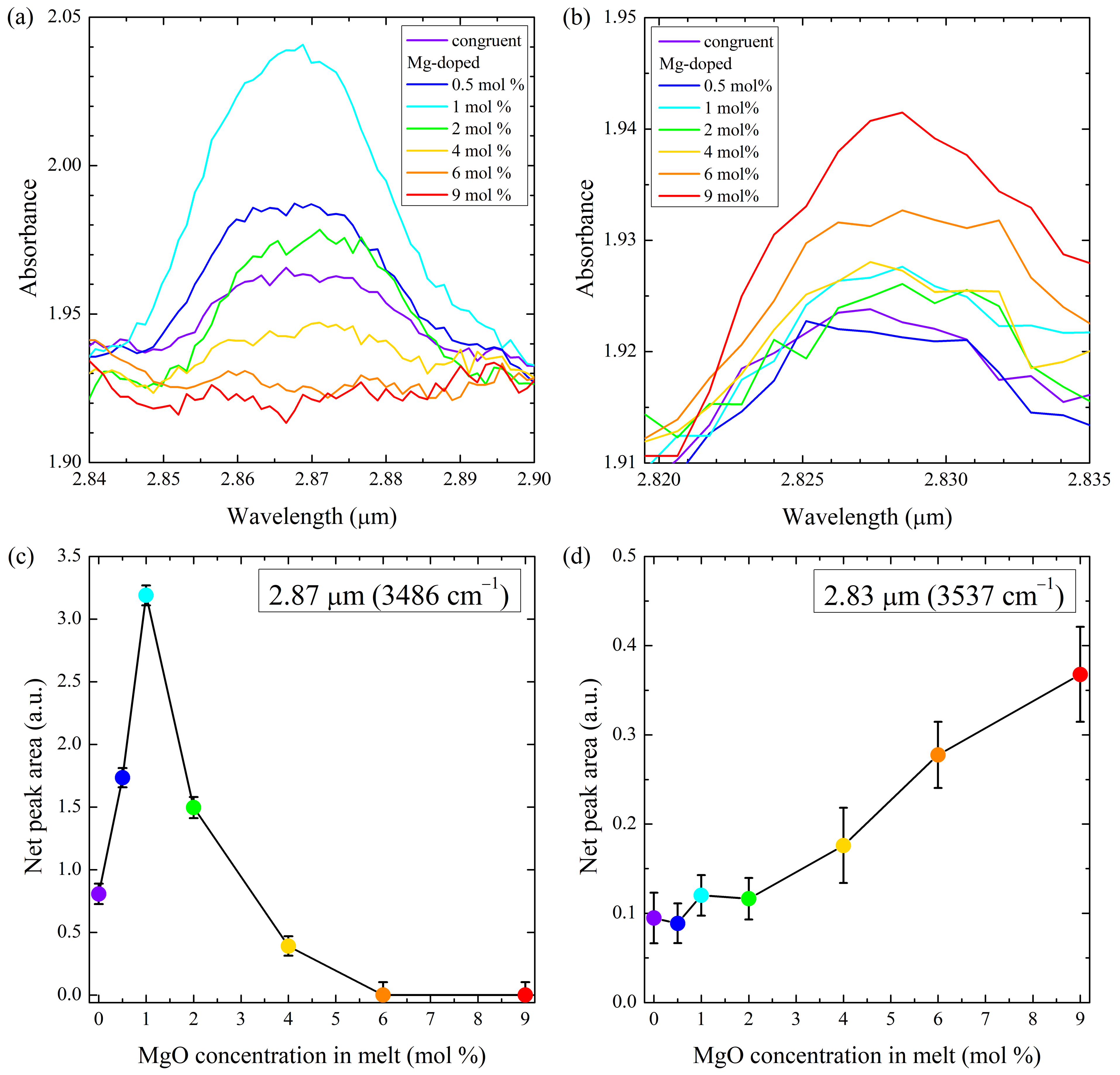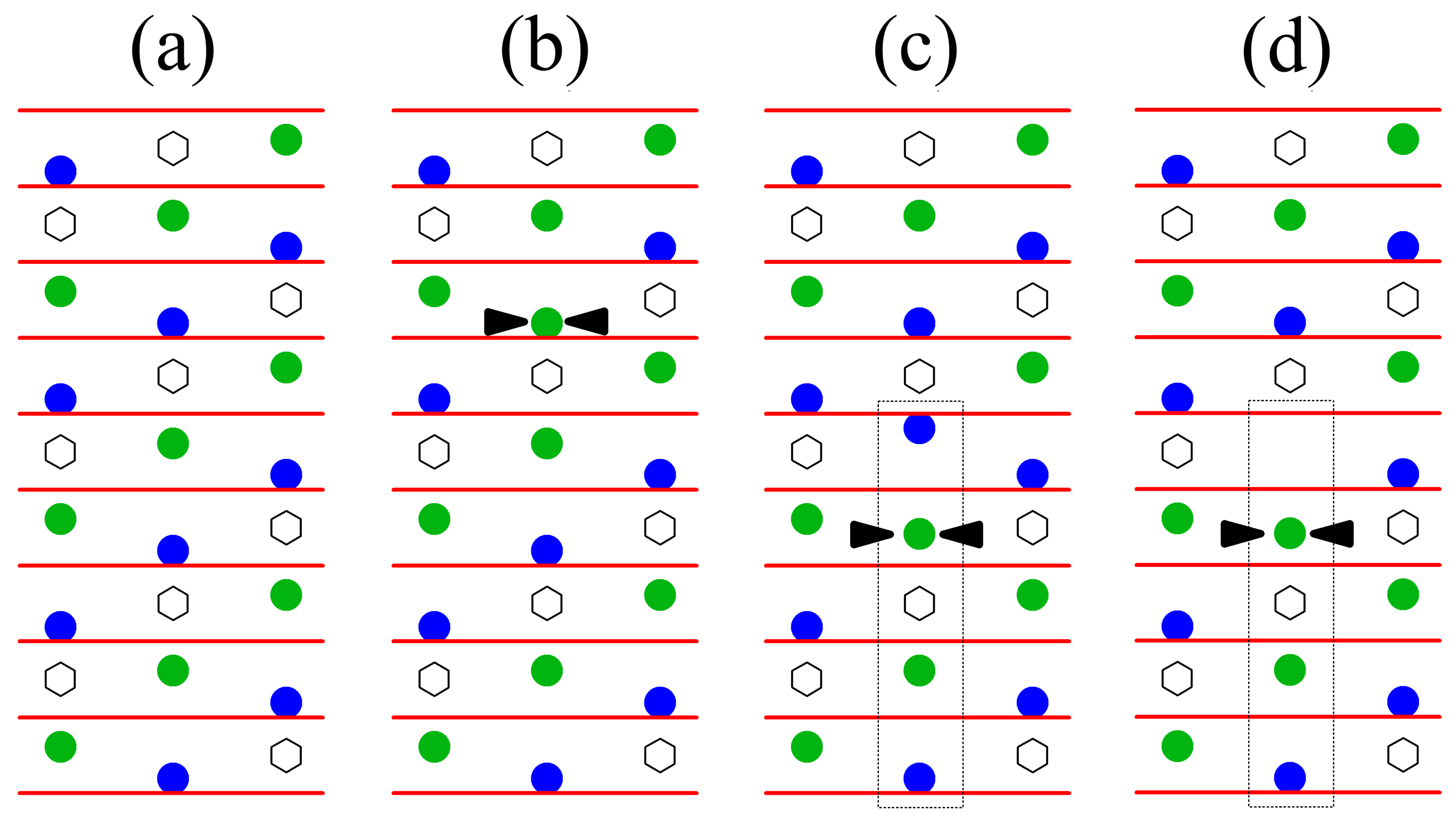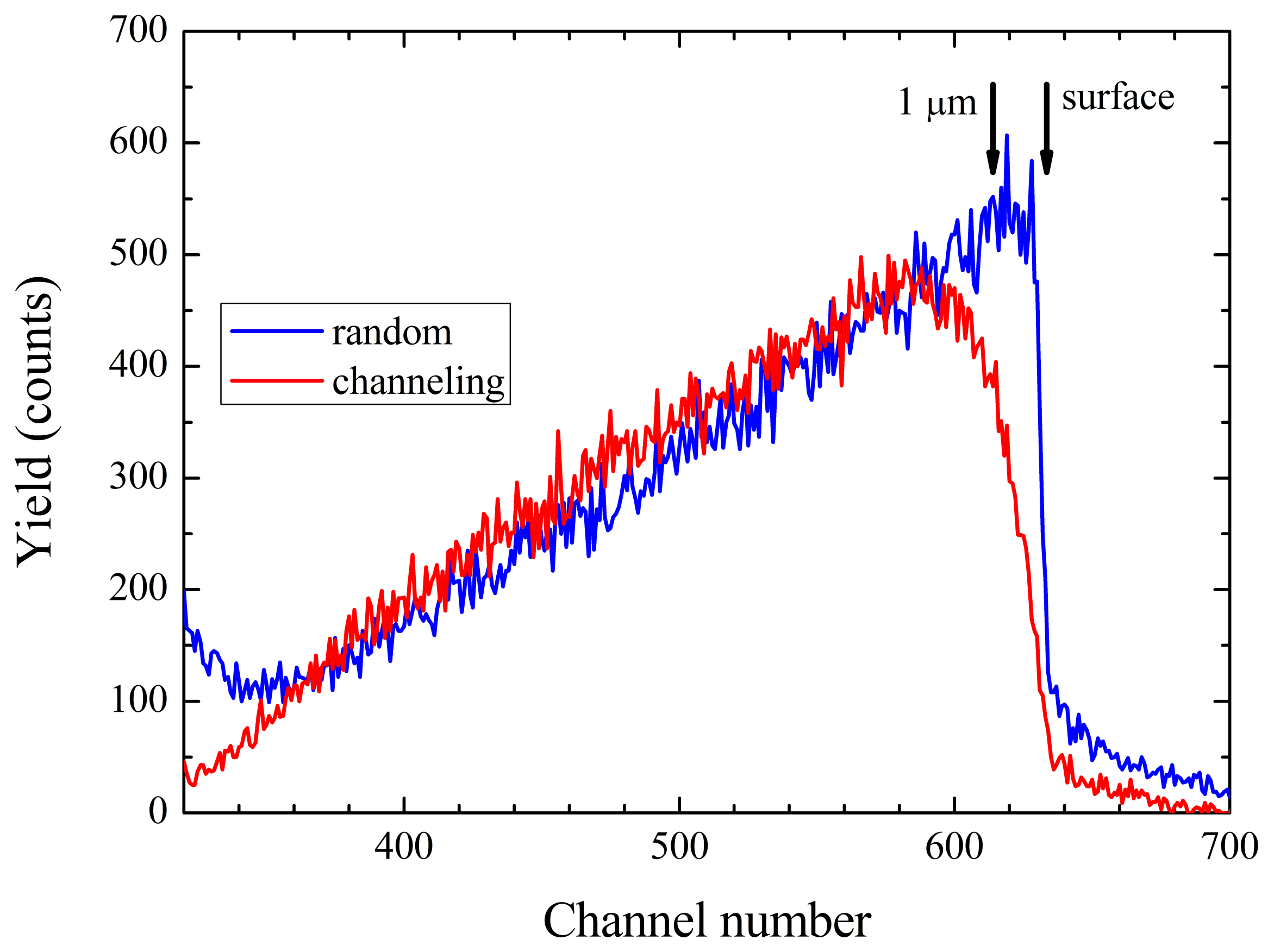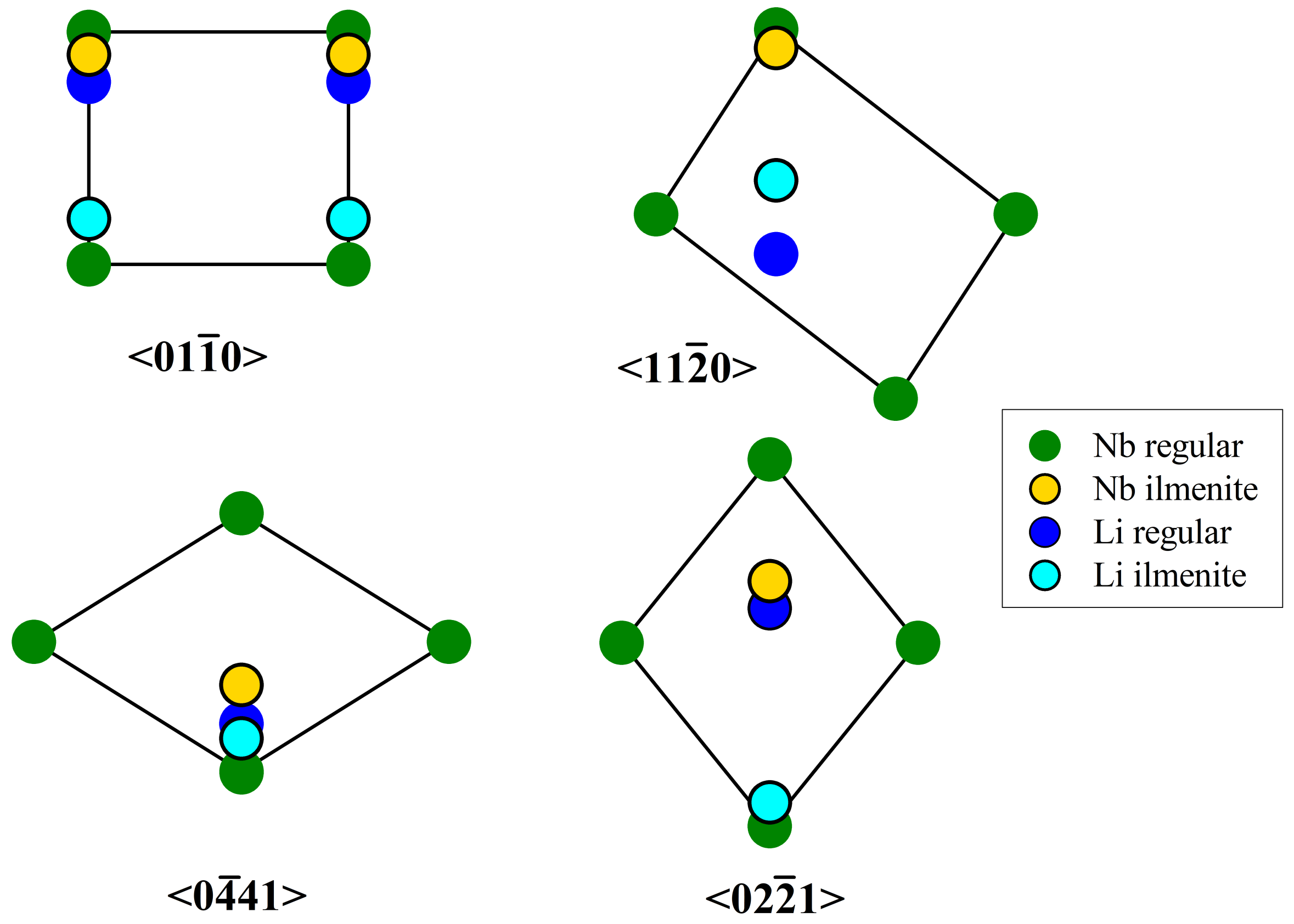Correlation between Infrared Absorption and Lithium Sublattice Disorder in Magnesium-Doped Lithium Niobate
Abstract
1. Introduction
2. Experimental Details
3. Results and Discussion
4. Conclusions
Funding
Institutional Review Board Statement
Informed Consent Statement
Data Availability Statement
Conflicts of Interest
References
- Arizmendi, L. Photonic Applications of Lithium Niobate Crystals. Phys. Stat. Sol. A 2004, 201, 253–283. [Google Scholar] [CrossRef]
- Rovillain, P.; Cardoso de Oliveira, R.; Marangolo, M.; Duquesne, J.-Y. Nonsymmetric spin pumping in a multiferroic heterostructure. Phys. Rev. B 2020, 102, 184409. [Google Scholar] [CrossRef]
- Ashkin, A.; Boyd, G.D.; Dziedzic, J.M.; Smith, R.G.; Ballman, A.A.; Levinstein, J.J.; Nassau, K. Optically-Induced Refractive Index Inhomogenities in LiNbO3 and LiTaO3. Appl. Phys. Lett. 1966, 9, 72–74. [Google Scholar] [CrossRef]
- Chen, F.S. Optically Induced Change of Refractive Indices in LiNbO3 and LiTaO3. J. Appl. Phys. 1969, 40, 3389–3396. [Google Scholar] [CrossRef]
- Furukawa, Y.; Sato, M.; Kitamura, K.; Yajima, Y.; Minakata, M. Optical damage resistance and crystal quality of LiNbO3 single crystals with various [Li]/[Nb] ratios. J. Appl. Phys. 1992, 72, 3250–3254. [Google Scholar] [CrossRef]
- Malovichko, G.I.; Grachev, V.G.; Kokanyan, E.P.; Schirmer, O.F.; Betzler, K.; Gather, B.; Jermann, F.; Klauer, S.; Schlarb, U.; Wöhlecke, M. Characterization of Stoichiometric LiNbO3 Grown from Melts Containing K2O. Appl. Phys. A 1993, 56, 103–108. [Google Scholar] [CrossRef]
- Lerner, P.; Legras, C.; Dumas, J.P. Stoechiométrie des monocristeaux de métaniobate de lithium. J. Cryst. Growth 1968, 3–4, 231–235. [Google Scholar] [CrossRef]
- Abrahams, S.C.; Marsh, P. Defect Structure Dependence on Composition in Lithium Niobate. Acta Cryst. B 1986, 42, 61–68. [Google Scholar] [CrossRef]
- Nassau, K.; Lines, M.E. Stacking-Fault Model for Stoichiometric Deviations in LiNbO3 and LiTaO3 and the Effect on the Curie Temperature. J. Appl. Phys. 1970, 41, 533–537. [Google Scholar] [CrossRef]
- Donnerberg, H.; Tomlinson, S.M.; Catlow, C.R.A.; Schirmer, O.F. Computer-Simulation Studies of Intrinsic Defects in LiNbO3 Crystals. Phys. Rev. B 1989, 40, 11909–11916. [Google Scholar] [CrossRef]
- Polgár, K.; Péter, Á.; Kovács, L.; Corradi, G.; Szaller, Z.S. Growth of Stoichiometric LiNbO3 Single Crystals by Top Seeded Solution Growth Method. J. Cryst. Growth 1997, 177, 211–216. [Google Scholar] [CrossRef]
- Zhong, G.G.; Jian, J.; Wu, Z.-K. Measurements of Optically Induced Refractive-Index Damage of Lithium Niobate Doped with Different Concentrations of Mg. In Proceedings of the 11th International Quantum Electronics Conference; Cat. No. 80 CH 1561-0. IEEE: New York, NY, USA, 1980; p. 631. [Google Scholar]
- Feng, X.; Wang, D.; Zhang, J. NMR Spectra of Mg Nuclei in Mg-Doped LiNbO3 Crystals. Phys. Stat. Sol. B 1990, 157, K127–K130. [Google Scholar] [CrossRef]
- Yatsenko, A.V.; Yevdokimov, S.V.; Sugak, D.Y.; Solskii, I.M. NMR Analysis of Mg Ion Localization in LiNbO3 Crystal. Acta Phys. Pol. A 2010, 117, 166–169. [Google Scholar] [CrossRef]
- Kling, A.; Kollewe, D.; Grabmaier, B.C. Lattice site Investigations for Mg in LiNbO3 by Combined RBS-PIXE-NRA-Channeling Experiments. Nucl. Instrum. Methods Phys. Res. Sect. B Beam Interact. Mater. Atoms 1992, 64, 232–236. [Google Scholar] [CrossRef]
- Cabrera, J.M.; Olivares, J.; Carrascosa, M.; Rams, J.; Müller, R.; Diéguez, E. Hydrogen in Lithium Niobate. Adv. Phys. 1996, 45, 349–392. [Google Scholar] [CrossRef]
- Smith, R.G.; Fraser, D.B.; Denton, R.T.; Rich, T.C. Correlation of Reduction in Optically Induced Refractive-Index Inhomogeneity with OH Content in LiTaO3 and LiNbO3. J. Appl. Phys. 1968, 39, 4600–4602. [Google Scholar] [CrossRef]
- Bryan, D.A.; Gerson, R.; Tomaschke, H.E. Increased Optical Damage Resistance in Lithium Niobate. Appl. Phys. Lett. 1984, 44, 847–849. [Google Scholar] [CrossRef]
- Jin, B.M.; Kim, I.W.; Guo, R.; Bhalla, A.S. UV-VIS and IR Optical Absorption Properties in MgO Doped LiNbO3 Crystals. Ferroelectrics 1997, 196, 305–308. [Google Scholar] [CrossRef]
- Kong, Y.; Xu, J.; Zhang, W.; Zhang, G. The Site Occupation of Protons in Lithium Niobate Crystals. J. Phys. Chem. Solids 2000, 61, 1331–1335. [Google Scholar] [CrossRef]
- Kovács, L.; Polgár, K.; Capelletti, R. IR Absorption Study of OH- in Pure and Mg-Doped LiNbO3 Crystals. Cryst. Latt. Def. Amorph. Mat. 1987, 15, 115–121. [Google Scholar]
- Sidorov, N.V.; Bobreva, L.A.; Palatnikov, M.N. Complex Defects in Mg-Doped Lithium Niobate Crystals Over a Wide Concentration Range in the OH Stretching Vibration Region. J. Appl. Spect. 2019, 86, 572–577. [Google Scholar] [CrossRef]
- Teplyakova, N.A.; Sidorov N., V.; Palatnikov, M.N. Determination of Stoichiometry, Concentration of OH Groups, and Point Defects in Lithium Niobate Crystals from Their IR Absorption Spectra. Opt. Spectrosc. 2020, 128, 1131–1137. [Google Scholar] [CrossRef]
- Furukawa, Y.; Kitamura, K.; Takekawa, S.; Niwa, K.; Yajima, Y.; Iyi, N.; Mnushkina, I.; Guggenheim, P.; Martin, J.M. The Correlation of MgO-Doped Near-Stoichiometric LiNbO3 Composition to the Defect Structure. J. Cryst. Growth 2000, 211, 230–236. [Google Scholar] [CrossRef]
- Yang, J.; Lai, M.; Shang, J.; Li, Q.; Zhang, L.; Sun, J. Defect Structure of Near-Stoichiometric Mg-Doped LiNbO3 Crystals Prepared by Different Method. J. Cryst. Growth 2022, 580, 126478. [Google Scholar] [CrossRef]
- Kling, A.; Marques, J.G. Unveiling the Defect Structure of Lithium Niobate with Nuclear Methods. Crystals 2021, 11, 501. [Google Scholar] [CrossRef]
- Rebouta, L.; da Silva, M.F.; Soares, J.C.; Sanz-García, J.A.; Dieguez, E.; Agulló-López, F. 7Li(p,α)4He, PIXE and RBS/Channeling Studies of the Lattice Site Location of Impurities in LiNbO3 and LiNbO3 Co-Doped with Magnesium. Nucl. Instrum. Methods Phys. Res. Sect. B Beam Interact. Mater. Atoms 1992, 64, 189–192. [Google Scholar] [CrossRef]
- Kling, A.; Kollewe, D.; Grabmaier, B.C. Dependence of the 7Li(p,α)4He Minimum Yield on the Mg Concentration for Proton Channeling. Nucl. Instrum. Methods Phys. Res. Sect. B Beam Interact. Mater. Atoms 1994, 85, 490–493. [Google Scholar] [CrossRef]
- Williams, E.K.; Ila, D.; Sarkisov, S.; Venkateswarlu, P.; Poker, D.B. Application of NRA/Channeling to Study He+ Implanted Waveguides. Nucl. Instrum. Methods Phys. Res. Sect. B Beam Interact. Mater. Atoms 1996, B118, 57–61. [Google Scholar] [CrossRef]
- Kling, A.; Marques, J.G.; Correia, J.G.; da Silva, M.F.; Diéguez, E.; Agulló-López, F.; Soares, J.C. Study of Structural Differences Between Stoichiometric and Congruent Lithium Niobate with Ion Channeling and PAC Measurements. Nucl. Instrum. Methods Phys. Res. Sect. B Beam Interact. Mater. Atoms 1996, 113, 293–295. [Google Scholar] [CrossRef]
- Kling, A.; Rebouta, L.; Marques, J.G.; Correia, J.G.; da Silva, M.F.; Diéguez, E.; Agulló-López, F.; Soares, J.C. Ion Beam Channeling and Hyperfine Interaction Analysis for the Characterization of Stoichiometry and Anti-site Population in LiNbO3. Nucl. Instrum. Methods Phys. Res. Sect. B Beam Interact. Mater. Atoms 1996, 118, 622–625. [Google Scholar] [CrossRef]
- Grabmaier, B.C.; Otto, F. Growth and Investigation of MgO-doped LiNbO3. J. Crystal Growth 1986, 79, 682–688. [Google Scholar] [CrossRef]
- Grabmaier, B.C.; Otto, F. Growth of LiNbO3 Single Crystals for Optical Applications. Proc. SPIE 1986, 651, 2–6. [Google Scholar] [CrossRef]
- Grabmaier, B.C.; Wersing, W.; Koestler, W. Properties of Undoped and MgO-Doped LiNbO3; Correlation to the Defect Structure. J. Cryst. Growth 1991, 110, 339–347. [Google Scholar] [CrossRef]
- Sommerfeldt, R.; Holtmann, L.; Krätzig, E.; Grabmaier, B.C. Influence of Mg Doping and Composition on the Light-Induced Charge Transport in LiNbO3. Phys. Stat. Sol. (A) 1988, 106, 89–98. [Google Scholar] [CrossRef]
- Donnerberg, H. Comments on the Defect Chemistry of Magnesium-Doped Lithium Niobate (LiNbO3). J. Solid State Chem. 1996, 123, 208–214. [Google Scholar] [CrossRef]
- Donnerberg, H.; Tomlinson, S.M.; Catlow, C.R.A.; Schirmer, O.F. Computer-Simulation Studies of Extrinsic Defects in LiNbO3 Crystals. Phys. Rev. B 1991, 44, 4877–4883. [Google Scholar] [CrossRef]
- Feng, X.-Q.; Tang, T.B. Mg-Doping Threshold Effect and H-Containing Defects in LiNbO3. J. Phys. Condens. Matter 1193, 5, 2423–2430. [Google Scholar] [CrossRef]
- Schlarb, U.; Betzler, K. Influence of the Defect Structure on the Refractive Indices of Undoped and Mg-Doped Lithium Niobate. Phys. Rev. B 1994, 50, 751–760. [Google Scholar] [CrossRef]
- Liu, J.; Zhang, W.; Zhang, G. Defect Chemistry Analysis of the Defect Structure in Mg-Doped LiNbO3 Crystals. Phys. Stat. Sol. A 1996, 156, 285–291. [Google Scholar] [CrossRef]
- Iyi, N.; Kitamura, K.; Izumi, F.; Yamamoto, J.K.; Hayashi, T.; Asano, H.; Kimura, S. Comparison Study of Defect Structures in Lithium Niobate with Different Compositions. J. Sol. State Chem. 1992, 101, 340–352. [Google Scholar] [CrossRef]
- Gröne, A.; Kapphan, S. Sharp Temperature Dependent OH/OD IR-Absorption Bands in Nearly Stoichiometric (VTE) LiNbO3. J. Phys. Chem. Solids 1995, 56, 687–701. [Google Scholar] [CrossRef]
- Holman, R.L.; Cressman, P.J.; Revelli, J.F. Chemical control of optical damage in lithium niobate. Appl. Phys. Lett. 1978, 32, 280–283. [Google Scholar] [CrossRef]
- Nunomura, K.; Ishitani, A.; Matsubara, T.; Hayashi, I. Second Harmonic Generation in a Sputtered LiNbO3 Film on MgO. J. Crystal Growth 1978, 45, 355–360. [Google Scholar] [CrossRef]





Disclaimer/Publisher’s Note: The statements, opinions and data contained in all publications are solely those of the individual author(s) and contributor(s) and not of MDPI and/or the editor(s). MDPI and/or the editor(s) disclaim responsibility for any injury to people or property resulting from any ideas, methods, instructions or products referred to in the content. |
© 2023 by the author. Licensee MDPI, Basel, Switzerland. This article is an open access article distributed under the terms and conditions of the Creative Commons Attribution (CC BY) license (https://creativecommons.org/licenses/by/4.0/).
Share and Cite
Kling, A. Correlation between Infrared Absorption and Lithium Sublattice Disorder in Magnesium-Doped Lithium Niobate. Materials 2023, 16, 797. https://doi.org/10.3390/ma16020797
Kling A. Correlation between Infrared Absorption and Lithium Sublattice Disorder in Magnesium-Doped Lithium Niobate. Materials. 2023; 16(2):797. https://doi.org/10.3390/ma16020797
Chicago/Turabian StyleKling, Andreas. 2023. "Correlation between Infrared Absorption and Lithium Sublattice Disorder in Magnesium-Doped Lithium Niobate" Materials 16, no. 2: 797. https://doi.org/10.3390/ma16020797
APA StyleKling, A. (2023). Correlation between Infrared Absorption and Lithium Sublattice Disorder in Magnesium-Doped Lithium Niobate. Materials, 16(2), 797. https://doi.org/10.3390/ma16020797







